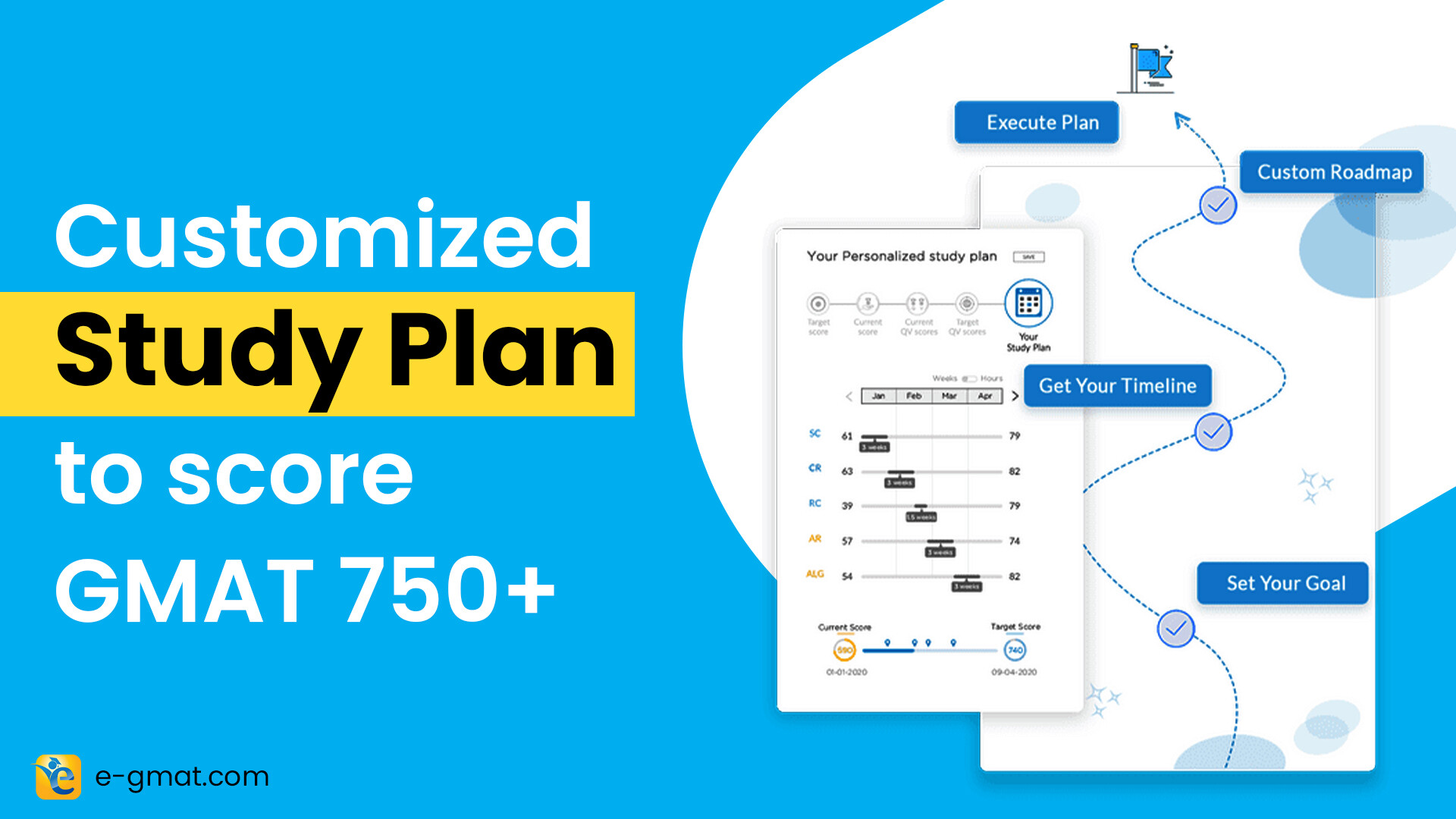Table Analysis (TA) and Graphical Interpretation (GI) are the two most tested concepts in the Data Insights section of the GMAT Focus Edition and the Table Analysis and Graphical Interpretation (TAGI) course is designed to help you make the most of it. The course is meticulously structured into distinct modules, with each module organized logically and designed to progressively strengthen your abilities, ensure your proficiency, and prepare you to master Graphical Interpretation (GI) questions with confidence.
Note: The TAGI course is a part of our Data Insights offering that includes three courses (Table Analysis and Graphics Interpretation, Two Part Analysis, and Multi-Source Reasoning) , a Deep Learning powered Personalized Study Planner, Scholaranium for Data Insights and GMAT Focus Edition Mocks.
The course has 140+ solved examples assessment exercises. The article below describes each of the modules.

- What skills do you build in the TAGI course?
- Why should I do the TAGI course after achieving my target abilities in Quant and Verbal courses?
- How much practice does the TAGI course provide
- What is the structure of the Table Analysis and Graphical Interpretation (TAGI) course
- Module 1: Introduction to Graphic Interpretation and Table Analysis
- Module 2: Fundamentals of Graphic Interpretation
- Module 3: Advanced Techniques in Graphics Interpretation
- Module 4: Practical Table Analysis Strategies
- Module 5: Applying Statistics in Graphics Interpretation
- Module 6: Applying Correlation in Data Insights
What skills do you build in the TAGI course?
The goal of the Graphical Interpretation course is to develop key data interpretation and analysis skills in students, prepare them for testing scenarios, and highlight the real-world applications and long-term benefits of these skills.
Watch this video to learn about key TAGI skills:
Hence, the key skills taught in the Graphical Interpretation (GI) course are as follows:
- Data Interpretation: This skill is critical for understanding and interpreting information displayed in various graphical forms such as line, bar, pie charts, and scatter plots.
- Analytical Reasoning: This involves drawing logical inferences from the data presented, discerning trends, identifying patterns, and pinpointing anomalies.
- Comprehension Skills: This pertains to the ability to understand and interpret both textual and visual information. The course suggests beginning data insights preparation only after achieving the required proficiency level in the verbal section.
- Quantitative Reasoning: While intricate calculations may not be necessary, grasping the quantitative facets of data such as percentage changes, ratio comparisons, and statistical elements is crucial. It’s recommended to attempt data insight section preparation only after satisfactory quantitative proficiency level has been achieved.
- Critical Thinking: Some GI questions will require students to evaluate arguments based on the data presented. The goal is to measure the ability to critically assess information and form sound judgments.
These skills are not only essential for excelling in the test but also in all fields where data interpretation and analysis are integral to the decision-making process. Overall, the skills acquired extend far beyond the scope of the test.
Ready to tackle the GMAT Focus Edition? e-GMAT offers a Personalized Study Planner and top-notch Free GFE mock exam to help you prepare effectively. As the most reviewed GMAT prep company on GMAT Club with 2600+ reviews we’re here to support your GFE journey. Take advantage of our free trial with the best quality content. Start your path to success today!
Why should I do the TAGI course after achieving my target abilities in Quant and Verbal courses?
The TAGI course utilized two critical skills that you acquire in the Quant and Verbal courses. We recommend that you do the TAGI (or any other DI course) after achieving your target ability (or at least a 70th percentile ability) in Quant and Verbal. Here is why:
- Comprehension Skills: The GI course requires strong comprehension skills, which are developed in the Verbal course. The ability to accurately understand and interpret textual information is key to tackling the textual components of GI questions.
- Quantitative Reasoning: The GI course requires a good grasp of quantitative facets of data such as percentage changes, ratio comparisons, and statistical elements. These skills are honed when you prepare for the Quant course. Therefore, achieving a satisfactory proficiency level in Quant skills before embarking on the GI course can enhance your performance on GI questions.
The quant and verbal provide foundational skills that are essential to successfully understanding and analyzing graphical data. The comprehension skills from the Verbal course and quantitative reasoning skills from the Quant course are integral to effectively interpreting the data, making sound judgments, and drawing logical conclusions in the GI course. Thus, it is suggested to attempt the GI course preparation only after gaining proficiency in the Verbal and Quant sections.
How much practice does the TAGI course provide
The TAGI course provides a comprehensive practice experience for students at various proficiency levels. Whether you are starting at the 30th percentile or have a higher starting ability at the 80th percentile, this course is designed to challenge and improve your skills, potentially propelling you to the 90th or even 100th percentile.
One of the key features of the TAGI course is the abundance of practice material it offers. It contains over 140 solved examples and practice questions, which is approximately 2.5 times the number provided in the Official Guide (OG) for 2023-24. This wealth of resources ensures that you have ample opportunities to practice and refine your skills, equipping you with the knowledge and confidence you need to excel. Read below to learn how the course progressively improves your ability to the 90th percentile.
What is the structure of the Table Analysis and Graphical Interpretation (TAGI) course
Watch this video to understand the e-GMAT’s MSR Course structure:
Start your GMAT Focus journey with our free GMAT Focus mock test to gauge your baseline score, and then create a personalized study plan. Dive into our free trial for targeted prep. Trusted by thousands with 2600+ reviews on GMAT Club, e-GMAT is your partner in mastering the GMAT. Contact us at support@e-gmat.com for expert guidance.
The following paragraphs outline the structure of the TAGI course.
Module 1: Introduction to Graphic Interpretation and Table Analysis
The Introductory module will walk you through the Question Type/Format, Skill Tested, and your learning path for the TAGI course.
Module 2: Fundamentals of Graphic Interpretation
The Second module, Fundamentals of Graphic Interpretation, lays the groundwork for mastering GI. This segment equips learners to tackle GI questions using inferences and observations drawn from datasets and scenarios, reducing reliance on calculations.
The focus is to truly understand the data: knowing what to visualize, what data to prioritize, and how to avoid being overwhelmed by raw data. Learners are encouraged to develop their observation and inference skills rather than leaning on calculations. The module also includes a refresher on fundamental tools like line charts and bar charts. By the end of this module, you should feel confident in interpreting datasets and approaching GI questions.
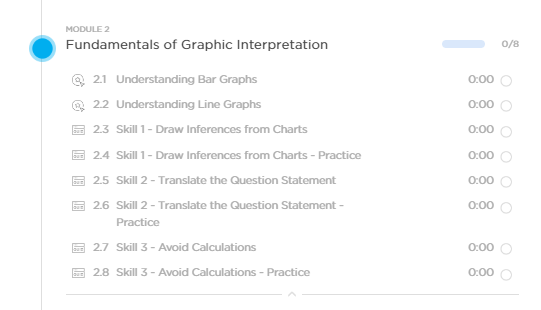
Module 3: Advanced Techniques in Graphics Interpretation
The third module builds on the foundations laid in the second module and introduces Advanced Techniques in Graphics Interpretation. Here, learners will encounter more complex questions and larger datasets. Calculations are introduced but only come into play towards the end of the solution process.
Concepts such as weighted mean probability, sum through segmentation, and rounding estimation are explored. A variety of chart types, including flow charts, organizational charts, Gantt charts, and Venn diagrams, are also introduced. By the end of this module, learners should be comfortable interpreting even complex charts and have the skills to answer approximately 80% of all GI questions.
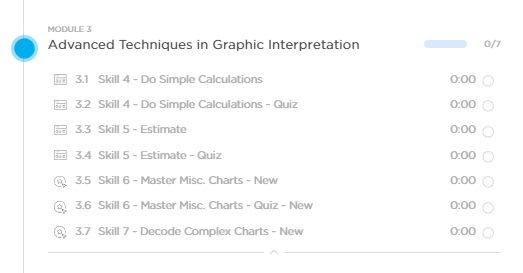
Module 4: Practical Table Analysis Strategies
Following the advanced techniques, the course transitions to “Practical Table Analysis Strategies”. This module enables learners to deepen their understanding by drawing inferences from tables, a critical skill for data analysis.
Learners’ foundations in statistics, specifically in a table context, are strengthened, paving the way for a profound understanding of data patterns. The concept of the weighted mean is introduced and then applied, reinforcing learners’ skill sets in navigating statistical landscapes.
Furthermore, the module features guided learning for table analysis, offering an opportunity to consolidate their knowledge under expert guidance. This interactive approach ensures a practical understanding of the course content. The module culminates in “Challenge Drills”, offering learners an opportunity to test their newly acquired skills under more demanding conditions.
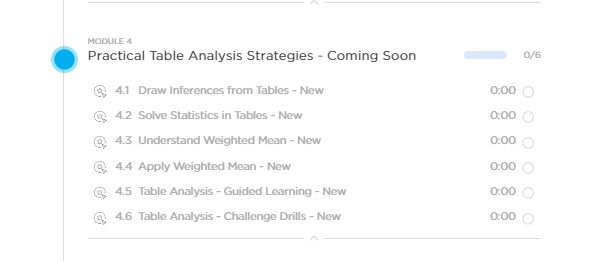
Module 5: Applying Statistics in Graphics Interpretation
The fifth module, “Applying Statistics in Graphics Interpretation”, focuses on applying statistical concepts in GI questions. By this stage, learners should feel comfortable with statistical concepts, especially after tackling table analysis questions. Here, learners apply the skills learned in the previous modules to questions that test their understanding of statistics. This hands-on approach helps reinforce knowledge and prepare learners for more advanced GI tasks.

Module 6: Applying Correlation in Data Insights
The final module introduces learners to the concept of correlation. Learners will apply this new concept to solve GI and table analysis questions that require understanding and applying correlations within data. This skill will help learners to identify and analyze correlations within data to provide insightful, data-driven answers.
Throughout the TAGI course, learners embark on a comprehensive journey, starting from understanding basic datasets, interpreting complex charts, and applying practical table analysis strategies, to mastering advanced statistical concepts. Each module builds on the skills learned in the previous ones, ensuring a holistic and progressive learning experience. The ultimate goal is to empower learners to master all GI questions with utmost confidence.
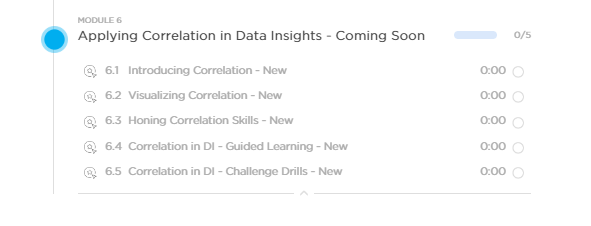
Did you know 9 out of 10 MBA Admissions decisions are made using a GMAT score? We can give you access to quality online content to prepare for GMAT. We have delivered 10x 700+ scores than the average GMATClub partner. Why don’t you take a free trial and judge it for yourself?







